Penguins are marine birds, although they sometimes also inhabit land, ice sheets, and sea ice. Penguins spend about half of their lives in the sea and half on land.
Penguins cannot fly but are good at swimming. When walking on land, it moves clumsily, with its feet on the ground and its body upright, relying on its tail and wings to maintain balance. When encountering an emergency, it can quickly lie down, stretch its wings, and crawl on the ice and snow; sometimes it can also use its tail and wings to control the direction and glide quickly on ice and snow cliffs and slopes. The swimming speed of penguins is astonishing. Adult penguins can swim at a speed of 20 to 30 kilometers per hour, which is faster than a 10,000-ton ship, and can even surpass the fastest whaling ship. The penguin's diving ability is comparable to that of world diving champions. It can jump more than 2 meters out of the water, soar from icebergs or ice, jump into the water, and dive to the bottom of the water. Therefore, penguins can be called strong swimmers, diving and diving experts.
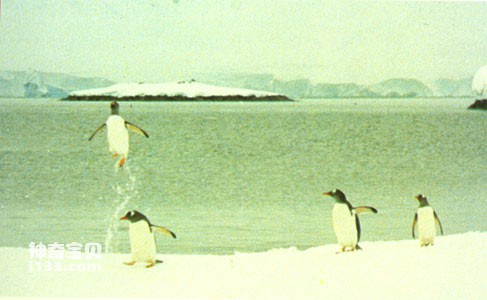
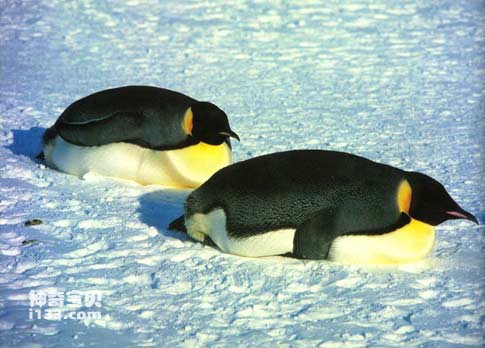
Penguins feed on marine zooplankton, mainly Antarctic krill, and sometimes some brachiids, squid and small fish. Penguins have good appetites. Each penguin can eat an average of 0.75 kilograms of food per day, mainly Antarctic krill. Therefore, penguins play an important role as predators in the Southern Ocean food chain. Penguins eat about 33.17 million tons of krill in Antarctica, accounting for 90% of the total consumption of Antarctic birds, which is equivalent to half of the krill eaten by whales.

Living on rock outcrops in ice-free areas
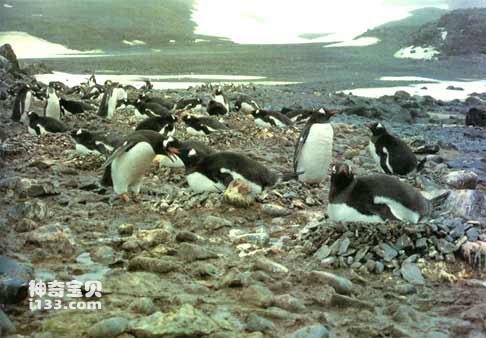
Build a nest with rocks
Penguin habitats vary by species and distribution area. Emperor penguins like to inhabit ice shelves and sea ice; Adélie penguins and gentoo penguins can live on sea ice or on rocky outcrops in ice-free areas. Life: Most penguins in the Subantarctic like to perch on rocks in ice-free areas, and often use stones to build nests.
Penguins like to live in groups. There are hundreds, thousands, tens of thousands, or even more than 100,000 to 200,000 in a group. On the ice shelves of the Antarctic continent, or on the icebergs and ice floes of the Southern Ocean, people can see groups of penguins gathering together. Sometimes, they line up in neat lines, facing in one direction, like a well-trained honor guard, waiting and welcoming visitors from afar; sometimes they line up in square formations with equal distances and intervals, like athletes performing group gymnastics, in very good formation. Neat and spectacular.
Penguin's character is honest, generous and very cute. Although penguins look sanctimonious, a little arrogant, and even domineering, when people approach them, they do not run away. Sometimes they seem as if nothing has happened, sometimes they seem shy and at a loss, and sometimes they look around and whisper to each other. Chatter. That honest and somewhat silly demeanor really makes people laugh. Maybe they rarely see people because they are curious.
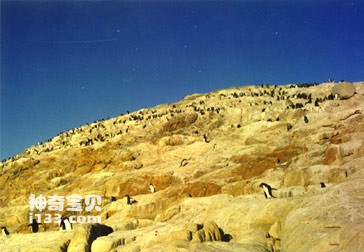
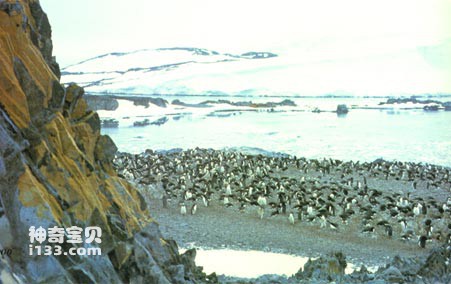
Penguin colony
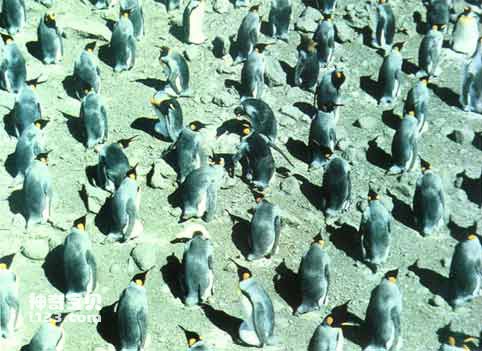
Penguin Square
1. Settling down a family
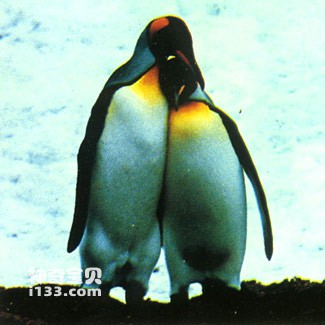
sympathize with each other
In the Antarctic summer, emperor penguins mainly live at sea. They hunt, swim, and play in the water. On the one hand, they exercise their bodies well, and on the other hand, they eat and drink enough to recharge their batteries and prepare for the winter breeding season.
In April, the Antarctic begins to enter early winter. Emperor penguins climb ashore and begin to look for a treasured place to "settle down". As they walk, they chase, play, fall in love, and look for mates. The love life of emperor penguins is quite interesting, and "love triangles" and "love affairs" also occur from time to time. If two male penguins fall in love with a female penguin at the same time, in order to compete for the love partner, they often fight with red faces and bruises all over their bodies. The loser tucks his tail between his legs and leaves in despair; the winner is elated, dances with joy, and quickly runs to his lover, mouth to mouth, chest to chest, snuggling tightly together. A similar situation will occur if two female penguins compete for a husband.

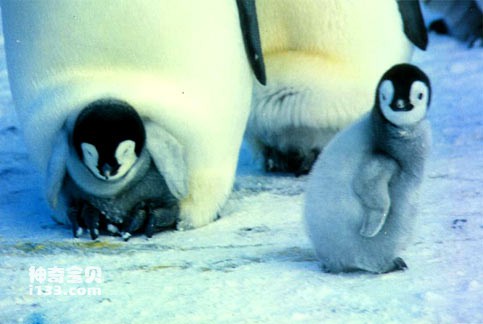
Take care of your children
What exactly is the penguin marriage system like? Is it a "monogamy" system, a "polygamy" system, or a "polygamy" system? There seems to be no precise research and verification so far. However, judging from the courtship behavior of emperor penguins, it seems that it is easy for people to accept that it is a "monogamous" family life.
After the emperor penguins went through the above-mentioned ups and downs in their love life, they chose a like-minded partner and found a breeding ground. As a result, their love life took a leap - they began to mate, conceive eggs, lay eggs, hatch eggs, and raise them. Family life of chick penguins.
2. Penguin hatching eggs
Female penguins carry eggs for about 2 months and start laying eggs around May. Emperor penguins lay one egg at a time, which is light green and shaped like a duck egg, but is much larger than a duck egg and weighs about half a kilogram; other penguins lay two eggs at a time, varying in size. All penguins breed once a year.
Female penguins also have pregnancy reactions during the pregnancy period, and their appetite is greatly reduced. In severe cases, they will not eat for up to a month. After the female penguin lays the eggs, she has completed her task, and the male penguins bear the heavy responsibility of incubating the eggs.
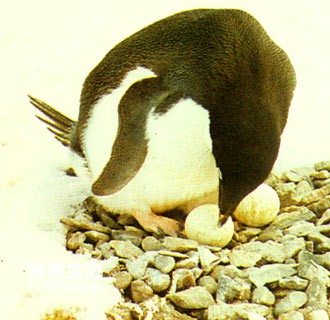
Male penguin hatching eggs
In the vast animal world, it seems that females have an instinct and a bounden duty to give birth to children, and people have long been accustomed to this natural thing. However, emperor penguins broke the rules and created the miracle of male penguins hatching eggs. This can not but be said to be a great feat in the animal world.
After the female penguin lays the egg, she immediately hands the egg to the male penguin. From then on, the female penguin's reproductive mission comes to an end. A day or two later, the female penguin safely left her warm family and went to the sea to look for food, play and have fun. Because it has not eaten for almost a month during pregnancy, the mental and physical exertion is very serious, and it is time to go to the sea to take a rest, eat a good meal, and restore its strength.
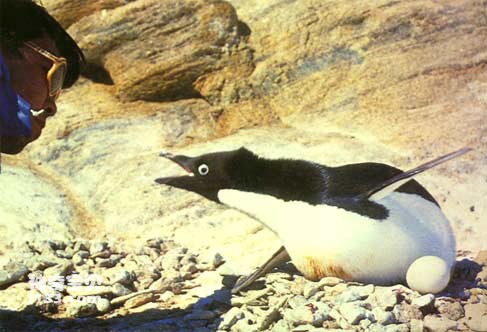
Go away!
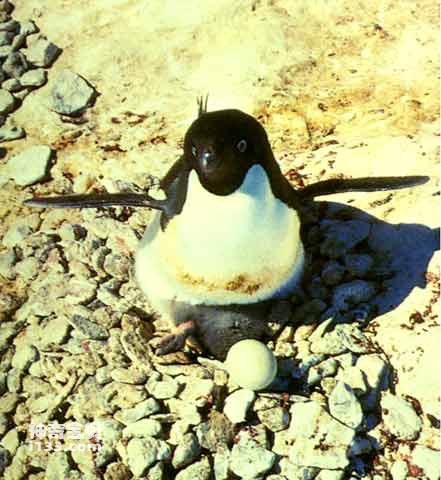
Do not make me angry!
It is indeed a difficult task for male penguins to incubate eggs. Because the penguin reproductive season coincides with the Antarctic winter, the climate is severely cold, windy and snowy. The reproductive period of penguins is chosen in the Antarctic winter because there are fewer enemies in winter, which can increase the reproduction rate. At the same time, when the little penguins grow up to be able to move around and forage independently, the Antarctic summer is coming, and the little penguins can leave their parents. Live a life of self-reliance. This is also the result of penguins adapting to the Antarctic environment.
During the incubation period, in order to avoid the cold and wind, several male penguins often stand side by side with their backs to the wind, forming a wind-blocking wall. When incubating eggs, the male penguin stands solemnly with his feet tightly together, using his tail as a support to share the body weight borne by his feet. Then he carefully moves the egg onto the back of his feet with his mouth, and moves his body and feet slightly. Until the egg stops on the instep. Finally, a long wrinkled belly drooped from the lower end of his abdomen, covering the egg like a safety bag. From then on, the male penguin bent his neck, lowered his head, stared at and protected the apple of his eye with all his strength, and stood for more than 60 days without eating or drinking. Until the young penguins emerge from their shells. Only then can it relax a little, move its body gently, and straighten its fluffy feathers. Flap your wings, refresh yourself, and get ready to complete the task of caring for the little penguin.
Newborn little penguin. He didn't dare to leave his father's arms and move around without permission. He still hid in the wrinkled skin under his father's belly. Occasionally, he would poke his head out and look around his father, taking a peek at the strange world surrounded by ice and snow. He would soon retract his head to the sky. The male penguin smiled happily when he saw the newborn baby. After a week, the little penguin dared to move a few times on his father's instep and change his position. During this period, the little penguin has no food and only relies on the egg yolk left by the female penguin in its body as nutrition to maintain its life. Therefore, it often chirps with hunger and even pecks the belly of the male penguin with its beak. However, how could the little penguin know the suffering and price his father had to pay during the three-month period: braving the severe cold, wind and snow, standing still, not eating or drinking, and only relying on consuming his own stored fat to provide food? Energy and heat ensure the temperature required for hatching eggs while maintaining their own minimum metabolism. During the period of incubating eggs and caring for chicks, a male emperor penguin will lose 10 to 20 kilograms, which is nearly half of his body weight.
3. Young penguins
Since the female penguin left her husband, she has had enough fun, eaten, and drank in the ocean near the coast. The loss during the pregnancy period has also been made up for, and she has become relaxed, fat, and energetic again. When he thought that his baby was about to be born, he hurriedly jumped ashore and embarked on the road back to his former home, looking for his long-lost husband and newborn child. However, at this moment, has the female penguin ever thought about whether her family members are a disaster or a blessing, bad or good?
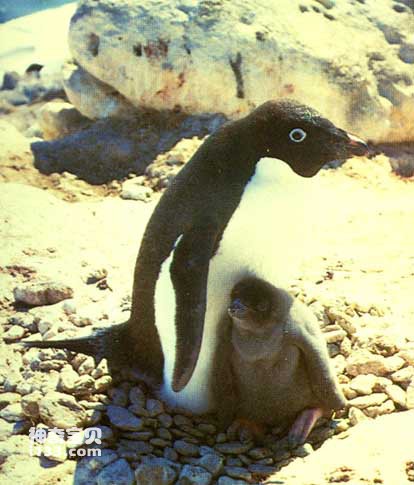
The hatching rate of male penguin eggs is difficult to reach 100%. The highest is 80% and the lowest is less than 10%. There are even tragic scenes of "annihilation". This is not due to the male penguin's "responsible" accident, nor is it due to his lack of experience and poor skills in hatching eggs. It is mainly due to the harsh Antarctic climate and the penguin's natural enemies.
There are two climatic factors that cause disasters, one is wind and the other is snow. If penguins are incubating eggs and encounter a powerful storm of 50 to 60 meters per second, it will be difficult to withstand it. Even building a wind-blocking wall will not help. It is conceivable that a powerful storm can blow away tents, carry away airplanes, move buildings, and throw objects weighing one to two hundred kilograms into the air, not to mention little penguins! When encountering such a natural disaster, only the lucky ones escape. Especially the snowstorm, that is, the powerful snow flow set off by the storm, roaring, roaring, galloping, and attacking everything in a rampage. The penguins hatching the eggs were either swept away or buried in the snow, and there were only a handful of survivors.
There are also two natural enemies of penguins. One is the vicious bird-the skua, and the other is the beast-the leopard seal. Although penguins choose to breed in the Antarctic winter to avoid attacks by natural enemies, penguins also have misfortunes and misfortunes. Natural enemies occasionally appear in winter. If the penguins hatching eggs encounter these ferocious birds and beasts, it will be disastrous. Either the penguin eggs will be swallowed or broken. This tragic situation happens from time to time.
Newborn penguins spend their early childhood on the insteps and sides of male penguins, who are both fathers and caregivers. Although the newborn penguin does not look very good-looking, with a fluffy body, grayish-yellow color, a pair of small eyes with inner rings, and a slanted walk, the male penguin still loves it very much. After the little penguin is born, he will sometimes chirp from hunger. The male penguin feels distressed and anxious, so he stretches his neck a few times, trying to spit out some nutrients from his throat sac to fill the little penguin's belly. However, this effort failed and nothing came out. It can be imagined that since the egg was hatched, the male penguin has not eaten for almost three months. His throat sac has long been empty, and there is nothing else he can squeeze out! It does this just to comfort the little penguin. Therefore, male penguins anxiously await the arrival of female penguins.
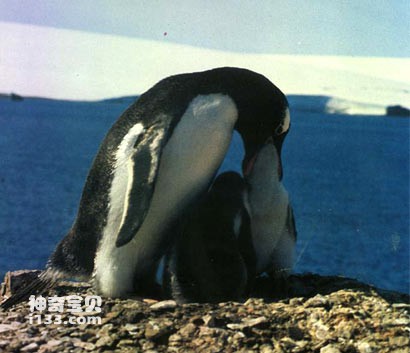
Penguin feeding
Relying on biological instinct and the unique magnetic positioning and direction finding function of birds, the female penguin accurately returned to the habitat where she gave birth to her children. Relying on the male penguin's call - the language of penguin communication and emotion exchange, the female penguin accurately recognized her husband and found her child. At this moment, the female penguin, apart from being intimate with her husband after a long separation, all she thinks about is her baby. The first gift it gives its baby is a good meal. When the little penguin saw his mother, he instinctively opened his mouth. The female penguin put her mouth into the little penguin's mouth and spit out mouthfuls of liquid food from her throat. This was the little penguin's first meal since birth. A full meal is also the first time it enjoys maternal love.
From then on, the little penguins were raised by male and female penguins in turns. After the male penguin handed the little penguin to his wife, he also ran to the sea to look for food. At this time, he looked thin and exhausted.
4. Baby Penguin Paradise
Due to the careful raising of its parents, the little penguin grows very fast. In less than a month, it can walk and play independently. In order to make it easier to go out for food and strengthen the protection and education of their offspring, penguin parents entrust their little penguins to the care of their neighbors. In this way, a "kindergarten" is formed in which one or several adult emperor penguins take care of a large group of little penguins. In the kindergarten, the aunt takes care of all the children as carefully as she takes care of her own children. The little penguins also obeyed their aunt's words and lived happily there. They waited for their parents to come back before taking them back.
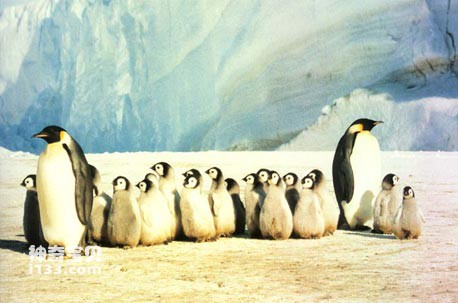
Emperor Penguin Kindergarten
The little penguins in the kindergarten will occasionally be attacked by ferocious birds and beasts. At this time, the aunts will send out an emergency signal, greet the neighbors, come for reinforcements, and attack the invading enemies in groups.
Although little penguins continue to grow and thrive under the careful care and care of families and collectives, due to the pressure of the harsh Antarctic environment and the infringement of natural enemies, the survival rate of little penguins is very low, accounting for only 20 to 30% of the birth rate.
The little penguins are about 3 months old, and the Antarctic summer is coming. They follow their parents into the sea to forage and swim. When midsummer in Antarctica comes, they have grown plump feathers and have sufficient physical strength, so they leave their parents and begin to live an independent life to support themselves.
5. Artificial breeding
In order to further study the living habits and special physiological functions of Antarctic penguins, biologists in many countries have long attempted to transport penguins back to domestic laboratories for artificial breeding. The earliest successes and the largest breeding scales were in the United States and the United Kingdom, which raised penguins in aquariums or marine parks that simulated the Antarctic environment.
As early as 1976, the Marine Park of the Herbbs SeaWorld Institute in San Diego, USA, successfully raised Adélie penguins and had them breed offspring. Later, the institute captured 45 emperor penguins from near McMurdo Station and raised them in the same marine park for the purpose of conducting year-round observation and research on penguins. On September 16, 1980, scientists there were happy to see that the emperor penguins hatched three little penguins. This was the first successful hatching of emperor penguins outside the Antarctic continent. In the four years from 1976 to 1980, the institute hatched and raised a total of 100 Adélie penguins, plus three newly bred emperor penguins, for a total of 103 little penguins.
In the Ocean Park, scientists simulated the Antarctic environment and built special homes for penguins. The emperor penguins' mating, egg-laying, egg-laying, and egg-hatching processes are completely consistent with the results observed in the Antarctic environment.
China's first Antarctic scientific expedition team captured four golden penguins from near the South Shetland Islands in Antarctica in February 1985, brought them back to China, and raised them artificially in the Qingdao Seafood Museum. In May 1985, one of them died due to illness, and the remaining three, one female and two male, live to this day. Scientists observed and studied the living habits and adaptability of Jintu penguins to the environment.
animal tags: penguin
We created this article in conjunction with AI technology, then made sure it was fact-checked and edited by a Animals Top editor.